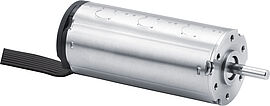Mechanical watches are actually an anachronism, as they are no longer really needed for measuring time. Nevertheless, demand remains high. Many purchasers are looking not only for a prestigious piece of arm jewellery but also feel a deep appreciation for the extraordinary refinement of the precision mechanics of their timepieces. They are based on the highly developed craftsmanship that has been passed on over the centuries from generation to generation, primarily in Switzerland. Most of the industry’s bigname manufacturers are located there.
Cluster for cutting-edge technology
Today, these manufacturers produce their products in quantities that a pure craft workshop – a watchmaker builds the entire watch from A to Z – could not handle. Although the most important work steps are still performed largely by hand, the work is shared and broken down into various processes. The skilled workers are supported in many of the steps by machines, which automate the process to a certain degree.
One such machine is the assembly station (French: poste d’assemblage) from Precitrame Machines. The Swiss company is based at approximately 900 m above sea level in Tramelan, a small town in the Bernese Jura, in the immediate vicinity of some of the most renowned watch manufacturers in the world. The region is also a typical cluster of hidden champions for precision mechanics, mechatronics and machine construction. Dozens of companies that are associated with watchmaking, arose from it or, among other things, serve as suppliers to the industry, are all based there in a small area. They are characterised by the same attributes as the well-known watch names: products of the highest quality and technology that is among the best in the world in the respective fields.
World leader in technology
Precitrame produces machines for rotary-indexing transfer and finishing for precision mechanical production of every type as well as the aforementioned assembly station for watchmaking. When the housing of this machine is closed, one sees a work surface that contains a small, round opening at the front centre. There, the watchmaker receives the movement to perform the next assembly step. Once completed, the watchmaker returns it to the same location. The workpiece is now transported onwards under the cover while the next one arrives for processing.
Mini-factory under the housing
Located under the cover is something that has the appearance of a miniature version of an assembly plant. Numerous conveyor belts run next to one another there. These move the workpieces back and forth, pass through a series of switches and can thereby direct them on different paths depending on what work step is currently being performed on the batch.
All movements, however, enter a loading device (French: chargeur) in the rear part of the station that lifts them from the conveyor belt and directs them to an automated process. This may involve, e.g., applying a microscopically fine drop of oil to a specific location. This unit is, however, primarily responsible for quality assurance. Sophisticated systems remeasure here to ensure that the assembly processes were performed with the desired precision.
Optical and acoustic measuring instruments are used to, e.g., measure the rate and amplitude of the regulating element or to check the completeness of the components. The measurement data is recorded automatically and transferred using the CANopen bus system. A small QR code on the workpiece carrier allows it to be associated with a specific watch. It is thereby possible to fully document all assembly steps performed at this station for each individual movement.
Gentle acceleration
Lift up from the conveyor belt and guide to a process step – that sounds easy. But this process poses a number of technical challenges. The delicate movements lie loose in their flat carriers. A sudden movement could cause them to fall out, be damaged and disrupt the process flow. At the same time, the distances that are travelled here are, with respect to the small dimensions, considerable. The vertical stroke of the loader, for example, is over 20 centimetres. Its work should, of course, not delay the cycle time of the entire machine. It is not enough to perform the individual processes slowly and, thus, in the safe range.
Furthermore, three processes must be precisely synchronised: the transport pallet with the workpiece carrier is moved to the gripper on a horizontal axis. This grips the carrier and moves vertically upwards. Once there, the gripper moves horizontally to the measurement station, where the intended routine is performed. An exactly coordinated profile is required for each of these movements: start up slowly, accelerate gently, brake cautiously and again end the process at slow speed. FAULHABER developed a custom solution to drive the three axes.
At its heart is a brushless DC-servomotor with 4-pole technology of the 2250 BX4 series. An integrated encoder with Hall sensor sends a precise position signal to the control, thereby providing the basis for reproducible processes. The motor for the vertical axis is also equipped with a brake for precisely regulating the deceleration following the acceleration. In the event of a process malfunction, e.g., a power failure, the brake also holds the specified position and prevents the gripper from falling down.
Three million test cycles
A lead screw with especially steep pitch developed specifically for this application by FAULHABER subsidiary MPS transfers the force of the motor over the entire length. The optimum material for the nut that moves back and forth on the lead screw was determined through complex endurance tests: the highly stable PEEK plastic, which is also used as material for medical implants, was found to be most suitable over the course of three million cycles.
The profile generator is responsible for performing the individual movements using software that is integrated in the servo drive of the motors. The parameters were optimized by the FAULHABER experts directly in Tramelan for this special application. The 2250 BX4 servomotor is the smallest on the market capable of performing this complex task. It also satisfies the other requirements that the assembly station places on the technology. It is actuated by an MCBL 3002 S – an extremely compact servo controller for brushless DC-motors.
Due to its compact design, another MCDC 3002 S is used as an additional CANopen sensor node. Motor 2232 BX4 CxD was used for the horizontal axes. Here, the entire servo electronics with CANopen interface are already integrated with the same diameter – a special feature in the 22 millimetre class.
The entire machine corresponds to the dimensions with which work is performed in this industry and is appropriately compact and filigree in design. Because up to three loaders must be integrated, space is even tighter. The gripper unit, which moves on the three axes, weighs over 600 grammes, however. The drive must therefore deliver peak performance in the smallest of volumes. Precitrame and its end customer are pleased with the good cooperation with the drive supplier: “The experts from FAULHABER worked with great commitment on the development of this solution. In addition to the outstanding product, we also received optimum technical support. They contributed in making our assembly station a model of success.”
Products



